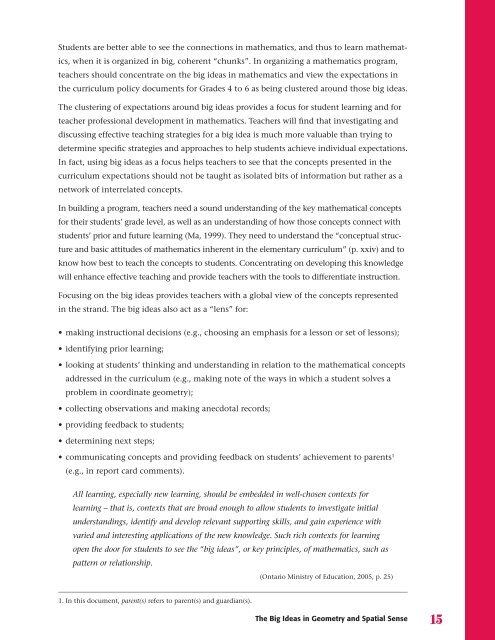Geometry and Spatial Sense, Grades 4 to 6 - EduGains
Geometry and Spatial Sense, Grades 4 to 6 - EduGains
Geometry and Spatial Sense, Grades 4 to 6 - EduGains
You also want an ePaper? Increase the reach of your titles
YUMPU automatically turns print PDFs into web optimized ePapers that Google loves.
Students are better able <strong>to</strong> see the connections in mathematics, <strong>and</strong> thus <strong>to</strong> learn mathemat-<br />
ics, when it is organized in big, coherent “chunks”. In organizing a mathematics program,<br />
teachers should concentrate on the big ideas in mathematics <strong>and</strong> view the expectations in<br />
the curriculum policy documents for <strong>Grades</strong> 4 <strong>to</strong> 6 as being clustered around those big ideas.<br />
The clustering of expectations around big ideas provides a focus for student learning <strong>and</strong> for<br />
teacher professional development in mathematics. Teachers will find that investigating <strong>and</strong><br />
discussing effective teaching strategies for a big idea is much more valuable than trying <strong>to</strong><br />
determine specific strategies <strong>and</strong> approaches <strong>to</strong> help students achieve individual expectations.<br />
In fact, using big ideas as a focus helps teachers <strong>to</strong> see that the concepts presented in the<br />
curriculum expectations should not be taught as isolated bits of information but rather as a<br />
network of interrelated concepts.<br />
In building a program, teachers need a sound underst<strong>and</strong>ing of the key mathematical concepts<br />
for their students’ grade level, as well as an underst<strong>and</strong>ing of how those concepts connect with<br />
students’ prior <strong>and</strong> future learning (Ma, 1999). They need <strong>to</strong> underst<strong>and</strong> the “conceptual struc-<br />
ture <strong>and</strong> basic attitudes of mathematics inherent in the elementary curriculum” (p. xxiv) <strong>and</strong> <strong>to</strong><br />
know how best <strong>to</strong> teach the concepts <strong>to</strong> students. Concentrating on developing this knowledge<br />
will enhance effective teaching <strong>and</strong> provide teachers with the <strong>to</strong>ols <strong>to</strong> differentiate instruction.<br />
Focusing on the big ideas provides teachers with a global view of the concepts represented<br />
in the str<strong>and</strong>. The big ideas also act as a “lens” for:<br />
• making instructional decisions (e.g., choosing an emphasis for a lesson or set of lessons);<br />
• identifying prior learning;<br />
• looking at students’ thinking <strong>and</strong> underst<strong>and</strong>ing in relation <strong>to</strong> the mathematical concepts<br />
addressed in the curriculum (e.g., making note of the ways in which a student solves a<br />
problem in coordinate geometry);<br />
• collecting observations <strong>and</strong> making anecdotal records;<br />
• providing feedback <strong>to</strong> students;<br />
• determining next steps;<br />
• communicating concepts <strong>and</strong> providing feedback on students’ achievement <strong>to</strong> parents1 (e.g., in report card comments).<br />
All learning, especially new learning, should be embedded in well-chosen contexts for<br />
learning – that is, contexts that are broad enough <strong>to</strong> allow students <strong>to</strong> investigate initial<br />
underst<strong>and</strong>ings, identify <strong>and</strong> develop relevant supporting skills, <strong>and</strong> gain experience with<br />
varied <strong>and</strong> interesting applications of the new knowledge. Such rich contexts for learning<br />
open the door for students <strong>to</strong> see the “big ideas”, or key principles, of mathematics, such as<br />
pattern or relationship.<br />
(Ontario Ministry of Education, 2005, p. 25)<br />
1. In this document, parent(s) refers <strong>to</strong> parent(s) <strong>and</strong> guardian(s).<br />
The Big Ideas in <strong>Geometry</strong> <strong>and</strong> <strong>Spatial</strong> <strong>Sense</strong> 1

















